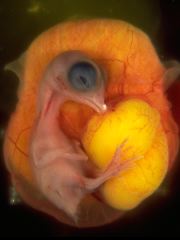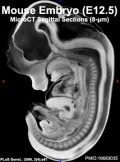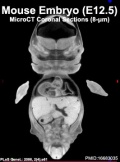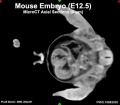Animal Development
| Embryology - 7 May 2024 |
|---|
| Google Translate - select your language from the list shown below (this will open a new external page) |
|
العربية | català | 中文 | 中國傳統的 | français | Deutsche | עִברִית | हिंदी | bahasa Indonesia | italiano | 日本語 | 한국어 | မြန်မာ | Pilipino | Polskie | português | ਪੰਜਾਬੀ ਦੇ | Română | русский | Español | Swahili | Svensk | ไทย | Türkçe | اردو | ייִדיש | Tiếng Việt These external translations are automated and may not be accurate. (More? About Translations) |
Introduction
A list of different animal embryos that have been used in embryology studies that can be found within the Embryology program.
The links are to more detailed pages with overviews of embryological development and the key experimental findings. There are also links to external resources and labs that use these models. Use the title below to open pages with more about information about that animals embryo development and additional pages that relate to that species. There is also an embryology page for K12 students with a table comparing Animal Development Times.
In 2009, science embryology students prepared group projects on some selected animal models of development. Project 1 - Rabbit | Project 2 - Fly | Project 3 - Zebrafish | Group Project 4 - Mouse | Project 5 - Frog | Students Page
| Animal Development: axolotl | bat | cat | chicken | cow | dog | dolphin | echidna | fly | frog | goat | grasshopper | guinea pig | hamster | horse | kangaroo | koala | lizard | medaka | mouse | opossum | pig | platypus | rabbit | rat | salamander | sea squirt | sea urchin | sheep | worm | zebrafish | life cycles | development timetable | development models | K12 |
Species Comparison Timeline
| Carnegie | Stage | |||||||||||||||||||||||
| Human | Days | 1 | 2-3 | 4-5 | 5-6 | 7-12 | 13-15 | 15-17 | 17-19 | 20 | 22 | 24 | 28 | 30 | 33 | 36 | 40 | 42 | 44 | 48 | 52 | 54 | 55 | 58 |
| Mouse | Days | 1 | 2 | 3 | E4.5 | E5.0 | E6.0 | E7.0 | E8.0 | E9.0 | E9.5 | E10 | E10.5 | E11 | E11.5 | E12 | E12.5 | E13 | E13.5 | E14 | E14.5 | E15 | E15.5 | E16 |
| Rat | Days | 1 | 3.5 | 4-5 | 5 | 6 | 7.5 | 8.5 | 9 | 10.5 | 11 | 11.5 | 12 | 12.5 | 13 | 13.5 | 14 | 14.5 | 15 | 15.5 | 16 | 16.5 | 17 | 17.5 |
| Note these Carnegie stages are only approximate day timings for average of embryos. Links: Carnegie Stage Comparison | ||||||||||||||||||||||||
| ||||||||||||||||||||||||
Animal Development Times
The table below lists the approximate development time for a large number of different animals, ranging from the opossum at 12 days to the elephant at 660 days.
|
Bat
|
Bat Development - Not a typical embryo used in developmental studies, but first alphabetically and an alternative mammalian model. A recent paper has detailed the short-tailed fruit bat (Carollia perspicillata) embryonic stages of development. |
Cow
|
Bovine Development - Bovine, not a typical embryological model, but extensively studied due to commercial value and more recently for breeding using IVF techniques. Development takes about 280 days.
|
Chicken
|
Dog
| Dog Development - Not a typical embryo used in developmental studies, much work is based on veterinary and breeders. |
Echidna
| Echidna Development - Not a typical embryo used in developmental studies, much work is still required to determine this unique monotreme embryonic stages of development. |
Fly
|
Fly Development - The fruitfly (drosophila) was and is the traditional geneticist's tool. It has been transformed to an magnificent embryologist's tool, with developmental mechanisms being uncovered in this system combined with homolgy gene searches in other species. The fly genome was one of the first to be been completely sequenced. In early development nurse cells sacrifice their cytoplasmic contents to allow egg growth and early pattern formation is through the localization of maternal messenger RNAs (mRNAs). |
Frog
|
Grasshopper
|
Grasshopper Development - The grasshopper has been used as a model in studies of neural development. |
Guinea Pig
|
Guinea Pig Development - The guinea pig has been used as a model animal in many animal model studies; developmental, dietary, tetragenic, including the effects of maternal temperature on development. |
Kangaroo
|
Kangaroo Development - The tammar wallaby genome has been recently sequenced. |
Lizard
|
Lizard Development - Lizards are members of the reptile class of air-breathing, cold-blooded (ectothermic) vertebrates with skin covered in scales. |

|
Mouse
|
|||||||||||||||||||||||||||||||||||||||||||||||||||||||||||||||||||||||||||||||||||||||||||||||||||||||||||||||||||||||||||||||
Opossum
Pig
|
Platypus
|
Platypus Development - Not a typical embryo used in developmental studies and we still no very little about the embryonic stages of this unique monotreme development. The platypus also has an amazing sex chromosome organisation. |
Rabbit
| The rabbit along with human, are the few species which show birth defects with thalidomide (teratogenic effects) which were not detected with prior testing on other species.
|
Rat
| The rat is available as inbred, outbred and mutant strains. They have been generally beaten as a model by their mice brethren, as the molecular tools that became available (stem cells, knockout genes, etc). Rat embryos do have the advantage of being much larger than mouse embryos and easy to breed. Rat development is also generally 1 day behind from mouse.
|
Salmon
|
Salmon Development - sockeye and chinook. |
Worm
|
Worm Development - Early embryological studies of the worm Caenorhabditis elegans (C.Elegans, so called because of its "elegant" curving movement) characterized the fate of each and every cell in the worm through all stages of development. This worm has recently had its entire genome sequenced. |
Zebrafish
Zebrafish Development - Zebrafish are seen as the latest and greatest "model' for embryological development studies. They can be easily genetically altered and develop as practically "see through" embryos, all internal development can be clearly observed from the outside in the living embryo.
Medaka Fish
|
Medaka - The Japanese rice fish (Oryzias latipes) is a member of the killifish family and used in several developmental studies. |
Other Resources
- Carnegie Stage Comparison - the human embryonic period proper is divided into 23 Carnegie stages. Criteria beyond morphological features include age in days, number of somites present, and embryonic length. This staging can be applied to all vertebrates, and most vertebrate embryos develop during the embryonic period in much the same way, we can directly compare the timing of development for different species.
- Embryo Staging Systems - stages are based on the external and/or internal morphological development of the vertebrate embryo, and are not directly dependent on either age or size.
Animal Model Differences
While several of the above animal species are used as models of human development, there are specific differences in comparison to human development.
- Links: Models of Human Development
Abnormalities
Raudsepp T & Chowdhary BP. (2016). Chromosome Aberrations and Fertility Disorders in Domestic Animals. Annu Rev Anim Biosci , 4, 15-43. PMID: 26884101 DOI.
External Links
External Links Notice - The dynamic nature of the internet may mean that some of these listed links may no longer function. If the link no longer works search the web with the link text or name. Links to any external commercial sites are provided for information purposes only and should never be considered an endorsement. UNSW Embryology is provided as an educational resource with no clinical information or commercial affiliation.
- National Research Council (US) Committee for the Update of the Guide for the Care and Use of Laboratory Animals. Guide for the Care and Use of Laboratory Animals. 8th edition. Washington (DC): National Academies Press (US); 2011. Bookshelf link
Glossary Links
- Glossary: A | B | C | D | E | F | G | H | I | J | K | L | M | N | O | P | Q | R | S | T | U | V | W | X | Y | Z | Numbers | Symbols | Term Link
Cite this page: Hill, M.A. (2024, May 7) Embryology Animal Development. Retrieved from https://embryology.med.unsw.edu.au/embryology/index.php/Animal_Development
- © Dr Mark Hill 2024, UNSW Embryology ISBN: 978 0 7334 2609 4 - UNSW CRICOS Provider Code No. 00098G













